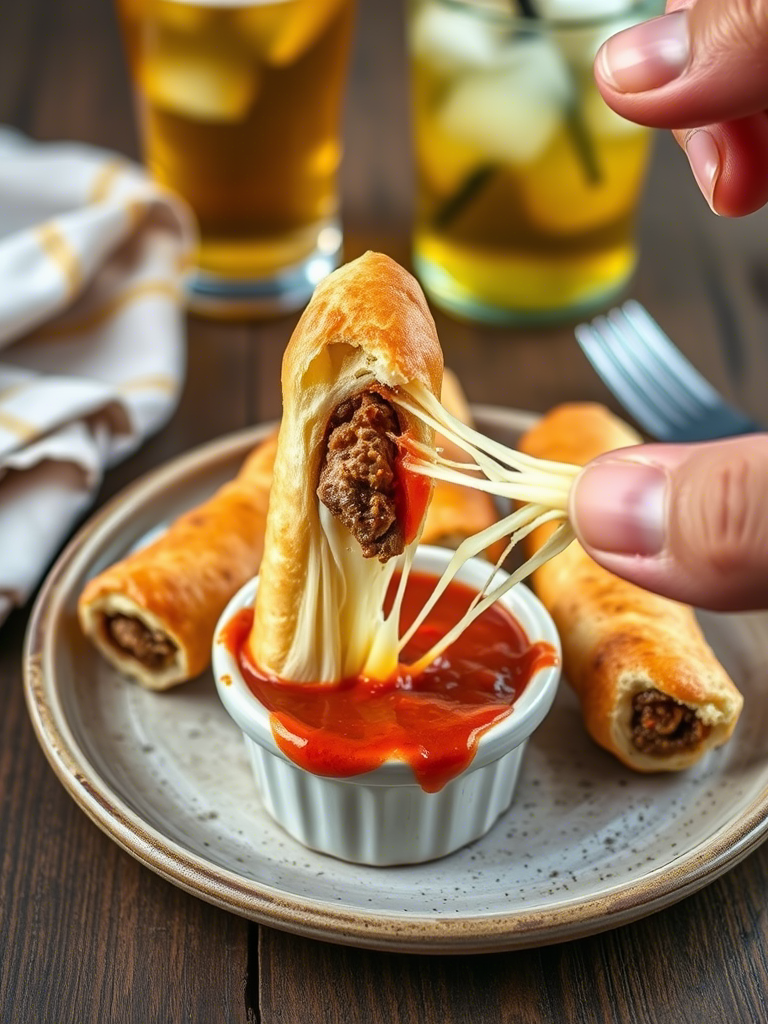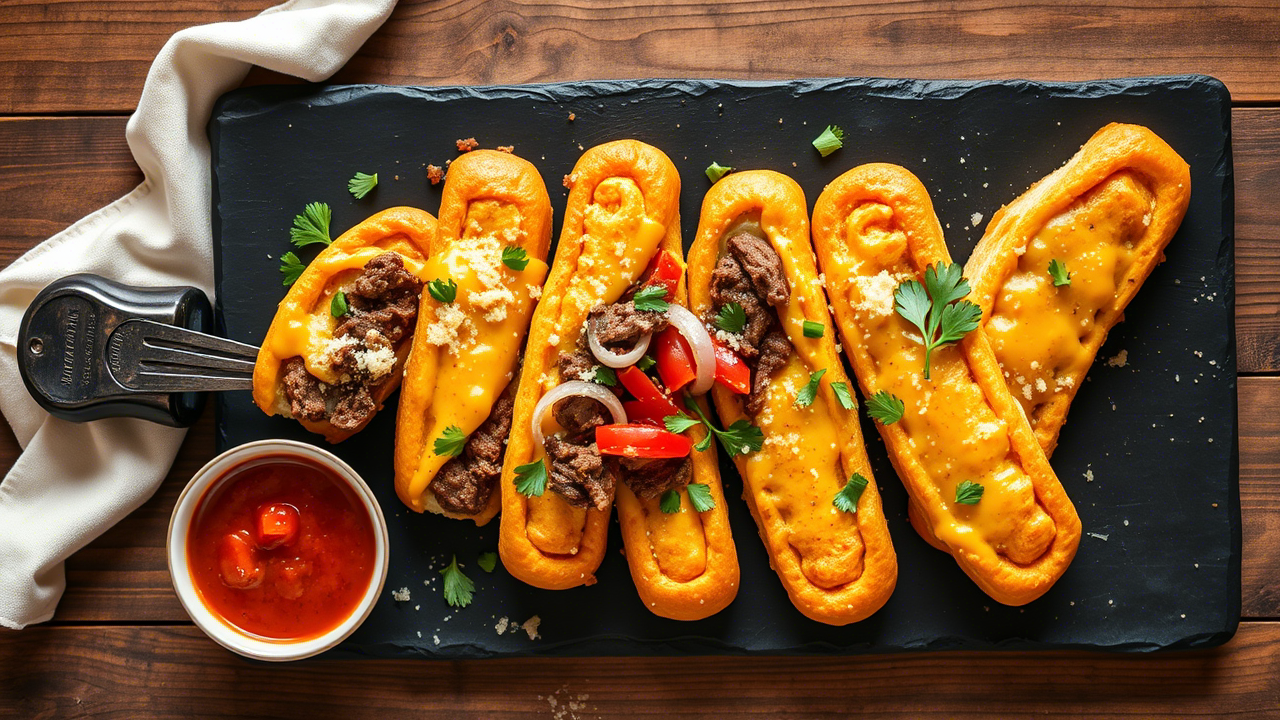Chefs chase trends, but some flavors just own the room. Philly cheesesteak—griddled beef, onions, and molten cheese—is one of them. Now imagine jamming all that meaty, oozy glory inside hot, golden breadsticks. You’re not just upgrading a side dish; you’re building something bold enough to hold its own on any menu.
This isn’t your regular gameday grub. It’s a showstopper that blends comfort food nostalgia with next-level execution.
In this piece, we’ll break down exactly how to construct the perfect Philly Cheesesteak Stuffed Cheesy Breadsticks. We’re not doing shortcuts here—no canned dough or microwaved beef. We’re cooking like pros, for pros. Expect ingredient deep dives, dough tactics, flavor science, and pro-level plating insight.
Let’s get to the guts of it.
Why Breadsticks Deserve This Glow-Up
Breadsticks have a rep. And not always the good kind. They’re often tossed on the table as afterthoughts—dry, forgettable, filler. But what if we flip that? What if breadsticks carry the meal?
Stuffing them with the rich, caramelized depth of a real-deal Philly cheesesteak makes them impossible to ignore. We’re talking layered flavor. Texture contrast. Portability and indulgence.
It’s casual enough for a pub menu, yet luxe enough to appear at a small-plates dinner. They cross category lines: snack, app, entrée? Yep.
The Dough: It’s Not Just a Wrapper, It’s a Player
You can’t slap any dough around steak and call it a day. It needs structure, chew, and a touch of stretch.
Use a high-hydration dough, like you’d find in artisan pizza making—around 65–70% hydration. That gives you the crisp chew on the outside with soft webbing inside. Enriched doughs (like brioche or challah) are a no-go here—they’ll collapse or turn mushy with juicy filling.
Pro tip: Let your dough cold-ferment overnight. This develops gluten structure slowly and gives the crust nutty depth. Professionals know: fermentation isn’t just about rise; it’s about flavor time.
And for shape, you’re not rolling these like calzones. Think baguette-sized breadsticks, roughly 7 inches, folded over with a seam on the bottom. You need an even wall of dough to hug that filling tight.
Let’s Talk Filling: The Soul of Cheesesteak
There are two sins to avoid when building a cheesesteak filling:
- Overcooking the beef
- Forgetting to balance fat with acidity
You want ribeye. Thin-sliced, not minced. If you can see daylight through the beef, it’s perfect. That marbled fat is going to keep things juicy and tender as it bakes.
Grill the ribeye on a blazing flat top or cast-iron. Get that Maillard reaction—that’s the tasty golden crust, not just a browning. Salt early, pepper late. Don’t overcrowd the pan or you’ll steam it, not sear it.
For onions, go half-sweated, half-caramelized. You want sweetness, but some bite too. Fully caramelized onions would turn into jam inside the breadstick.
Here’s a little secret most don’t think of: Add a splash of white vinegar or pickled jalapeño brine to the mix. Just a bit. That acid will cut the fat and wake the whole thing up.
Mushrooms? Optional. But if you do, dry sauté them separately until they squeak. Never toss ’em raw into the beef—they’ll bleed water and ruin the texture.

Cheese Science: Goop Factor Matters
You’re not just tossing cheese in for taste—it needs to melt, stretch, and bind.
Classic cheesesteak calls for Cheez Whiz, Provolone, or American. For breadsticks? You want a blend.
Use:
- Low-moisture mozzarella for that stretch
- Sharp provolone for that umami bite
- A dab of cream cheese or Whiz to keep things creamy inside when baked
You don’t want that cheese escaping into the dough. So it helps to chill the filling slightly before stuffing. Cold cheese melts slower—giving the dough time to form structure before things get messy.
Assembly: Layering Like a Pro
Once your dough has proofed and you’ve got your filling cooled and ready, here’s the construction:
- Roll dough into ovals about ¼ inch thick
- Lay beef-onion mix straight down the middle—don’t overfill
- Top with cheese (and maybe a sprinkle of garlic butter—why not?)
- Fold over like a log, pinch seams tight, and roll to seal
Brush the tops with egg wash + garlic oil + Parmesan. That’s your color and flavor bomb right there. Don’t skip it.
Slash the tops gently for steam release, but don’t go too deep—you’re not making baguettes.
Baking Tactics: Getting That Crust Just Right
Bake at 450°F on a pizza stone or inverted steel sheet. Hot base = crispy base. Professional ovens get to 600°F, but most home ovens top at 500°F. That’s still fine.
Bake until golden—about 12–15 minutes. The cheese might ooze a bit at the seams. That’s good. Let it.
You want a crust you can thump. Not a soft, sleepy shell. Give it 5 minutes resting time before slicing, or the filling will fall apart.
Serving & Pairing Ideas for Real-World Menus
If you’re putting these on a restaurant menu, plate them whole or halved, standing tall in a basket or stacked on a board.
Add ramekins of garlic aioli, hot cheese dip, or even a beef jus.
And pair with:
- IPA or amber ale for the bitterness to match richness
- Fizzy sodas (cola or ginger beer) for casual menus
- A smoky Cabernet for elevated settings
You can also offer variations. Think chicken cheesesteak, or even mushroom-Swiss for vegetarians.
The Business of Breadsticks: Why They Sell
From a food cost perspective, these are golden. Beef is the biggest cost. But dough, cheese, and onions? Cheap. And if you buy primal cuts and slice in-house, you control yield and waste.
They’re hand-held, craveable, and Instagrammable. You can prep the components ahead. Freeze raw. Bake to order. That’s gold in a high-volume kitchen.
Also—kids love them. Adults devour them. Late-night menus? Perfect. Upsell with dips or drinks? Done.
According to a 2023 National Restaurant Association survey, 60% of consumers prefer shareable starters, and 48% say they’re more likely to try fusion or hybrid dishes in that format. These breadsticks check both boxes.

Common Mistakes That’ll Sink Your Batch
Even pros mess this up. Here’s what to watch for:
- Underseasoned filling – Always taste it before assembly.
- Too wet – Drain excess fat and moisture before stuffing.
- Cheap cheese – It won’t melt right and tastes bland.
- Raw dough centers – Bake longer or lower your hydration slightly.
Also: Don’t proof the shaped breadsticks too long. Over-proofing will make them soft and leaky.
Trends & Future Flavors
This concept is ripe for experimentation.
Try:
- Korean bulgogi cheesesteak with gochujang aioli
- BBQ brisket with smoked cheddar
- Impossible meat versions for plant-based diners
Breadstick hybrids like these are part of the comfort food reinvention trend—a market that’s grown 18% year-over-year in North America alone (Datassential, 2024).
It’s not about novelty anymore—it’s about recognizable comfort with elevated execution. These hit the mark.
Final Crumbs: What to Take Away
Philly Cheesesteak Stuffed Cheesy Breadsticks are more than just a fusion dish—they’re a strategic upgrade. They offer:
- Familiarity with a twist
- Portable indulgence
- Menu versatility across formats
- Cost-efficiency with high perceived value
From scratch dough to seared ribeye, this recipe rewards attention to detail. Whether you’re slinging them from a food truck or plating them in a test kitchen, these breadsticks deliver impact bite after bite.
And if you’re not already dreaming up your next stuffed breadstick combo, well, your competitors probably are.
So… grab your ribeye, roll some dough, and start stuffing brilliance into every bite.
FAQs
What kind of beef is best for Philly Cheesesteak Stuffed Cheesy Breadsticks?
Thinly sliced ribeye is ideal for tenderness and rich flavor.
Can I use store-bought dough for this recipe?
You can, but homemade high-hydration dough gives much better texture and flavor.
What cheeses work best inside the breadsticks?
A mix of low-moisture mozzarella, sharp provolone, and a bit of cream cheese melts best.
How do I prevent soggy breadsticks?
Drain excess fat from the filling and don’t overstuff the dough.
Can these be made ahead of time?
Yes, you can assemble and freeze them raw, then bake fresh as needed.
What’s the best way to serve these?
Serve hot with dipping sauces like garlic aioli, cheese sauce, or beef jus.
How long should I bake the breadsticks?
Bake at 450°F for about 12–15 minutes until golden and crispy.
How do I keep the cheese from leaking out?
Seal the dough seams tightly and chill the filling slightly before stuffing.
Are there vegetarian alternatives?
Yes, use mushrooms and Swiss cheese or plant-based meats as filling.
Can I proof the dough overnight?
Yes, cold fermentation overnight actually enhances flavor and structure.
What drink pairs well with these breadsticks?
IPAs, fizzy sodas, or smoky red wines pair wonderfully with the richness.
Can I use chicken instead of beef?
Absolutely—thinly sliced grilled chicken makes a great variation.
What’s the biggest mistake to avoid?
Overfilling or underbaking, which leads to soggy or raw centers.
Are these good for food trucks or events?
Yes, they’re portable, prep-friendly, and incredibly craveable for on-the-go eating.

Mariana is a passionate home cook who creates delicious, easy-to-follow recipes for busy people. From energizing breakfasts to satisfying dinners and indulgent desserts, her dishes are designed to fuel both your body and hustle.
When she’s not in the kitchen, she’s exploring new flavors and dreaming up her next recipe to share with the Foodie Hustle community.

